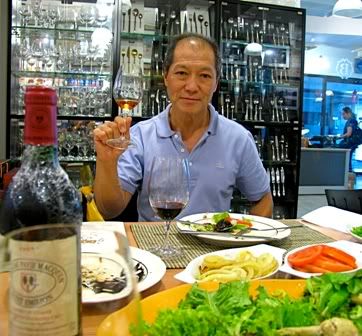I'm not quite a member of the press, my occasional wine-related magazine articles hardly qualify me as one. However, for Bacchus' Press Lunch for visiting Château Lynch-Bages proprietor, Jean-Michel Cazes, this past Thursday, the 26th November 2009, at Old Manila, I was asked to attend in Raul Manzano's stead to cover the event. Of course, I readily accepted. Though Metro Society sent Zari over to take photographs, I, naturally, also took some of my own.
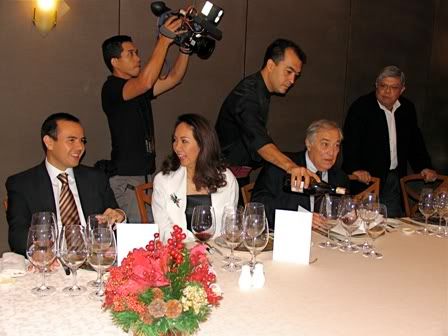
L-R Seated: Dave Celdran, Ana Sobrepeña, J-M Cazes
I've actually met J-M Cazes on a few occasions, the first time on the 6th March 2006, at a Bacchus dinner featuring his wines; Jojo Madrid, Gerry de Jesus and I arrived early so we had J-M all to ourselves to chat with for quite a while. The other times I bumped into him were at a couple of wine events in Hong Kong and a few times with the Miailhes in Bordeaux. I've actually toured Château Lynch-Bages once and eaten at its Café Lavinal a few times, the last time being in June 2007 with lady-chefs Myrna Segismundo and Jill Sandique before spending a rainy afternoon at the old town of Pauillac.
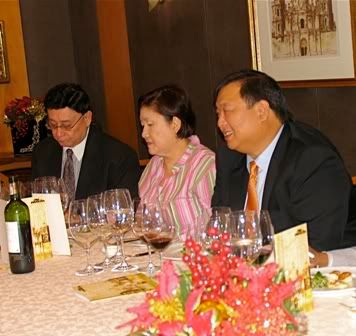
L-R: Johnny Litton, Mickey Fenix and Alex Lichaytoo
More importantly, I am very familiar with the grand vin of Lynch Bages, the crown jewel of J-M Cazes stable of wine estates, having repeatedly enjoyed, to the best of my recollection, at least 18 of his vintages, namely: 1982-1983, 1985-1990, 1993-1996, 1998-2001, 2005 and 2006. Obviously, Lynch-Bages is a wine I favor, having gone through my last batch of their 1999s much faster than I should have.
In a nutshell, Lynch Bages is a showpiece for the Pauillac appellation; it's wines are consistently well-crafted, long-lived, displaying a subtle, dignified power, great harmony, complexity and admirable balance in its deep, typical earthy notes of blackcurrant, cassis, cedar, violets, lead pencil shavings, gravel and dark spice. In any event, we were to have several of the wines from J-M's stable during lunch.
Château Lynch-Bages was so named after Thomas Lynch, son of Irish immigrant-businessman John Lynch. Sometime in the early-mid 18th century, Thomas married Elizabeth Drouillard who had inherited vineyards situated in Bages, including those on the Grand-Puy plateau. By the first quarter of the 19th century, the estate was sold to a Swiss wine merchant named Sebastian Jurine, under whose watch Lynch-Bages was classified a 5th growth (cinquième cru) in the 1855 Classification.
Many years, three inheritances and two sales later, Jean-Charles Cazes, J-M's father, purchased the estate in 1939. In 1974, J-M Cazes took full control of Lynch Bages, and, in 2006, passed the baton to his son and father's namesake, Jean-Charles. Prior to this, J-M also headed AXA's wine portfolio for several years until 2001 when he opted to concentrate on expanding the Lynch-Bages group of wineries.
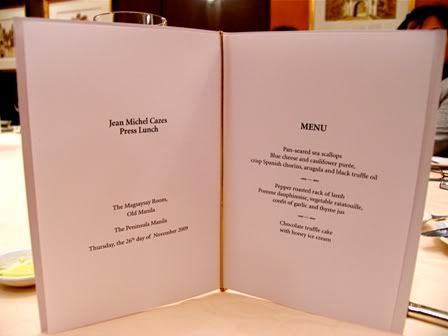 Being already conversant in the history of the estate and familiar with the Cazes family's wines, I had an interesting chat with J-M Cazes and Dave Celdran about agneau de Pauillac, the area's famed baby (milk-fed) lamb, and certain unscrupulous businessmen's attempts at passing on their inferior products as the real deal. In the meantime, some wines were already being poured:
Being already conversant in the history of the estate and familiar with the Cazes family's wines, I had an interesting chat with J-M Cazes and Dave Celdran about agneau de Pauillac, the area's famed baby (milk-fed) lamb, and certain unscrupulous businessmen's attempts at passing on their inferior products as the real deal. In the meantime, some wines were already being poured: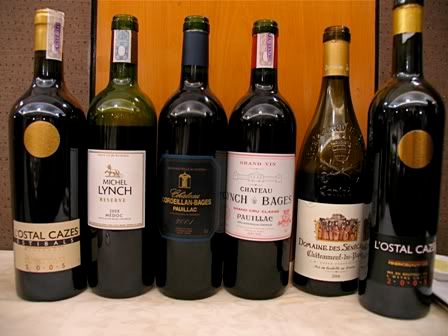 2006 Domaine des Sénéchaux Châteauneuf-du-Pape - I first tried this over a working lunch at the Lichaytoo brothers' Bacchus Kitchen on the 26th October 2009. My notes from that time were as follows:
2006 Domaine des Sénéchaux Châteauneuf-du-Pape - I first tried this over a working lunch at the Lichaytoo brothers' Bacchus Kitchen on the 26th October 2009. My notes from that time were as follows:An old and respected name in CDP, now owned by J-M Cazes (known best for his Lynch Bages). I'm not very familiar with recent vintages of the Rhône in general, but quick research shows Jancis Robinson and other respected reviewers speak well of (the area's vintage 2006).
This wine's dominant "grapey" scent shows the dominance of grenache (which, as far as I know, is pretty much the norm of CDP blends), with typical garrigue (with thyme and lavender particularly noted) and captivatingly subtle touches of animal (the mourvèdre more than likely) and truffle complexing the moderately spiced fruit. What made me really like this wine were its admirable harmony and balance - not overly hot/alcoholic, exceedingly-ripe and blatantly fruit-forward as many more modernly-styled ones are.
This is smoothly refined, proper and has a classic cut to it. Definitely this is a style I like and prefer. The first few sniffs and sips brought roast venison to mind. Available at Bacchus at around P2600 more or less.
Amusingly, when someone asked how much this wine retails for, I knew Bacchus' price more than Clifford, Bacchus' CFO. I obviously spend too much time at his wine shop.
2005 Michel Lynch Reserve - This red blend falls under the general Médoc Appellation d'Origine Contrôlée (AOC). Basically, this means the grapes which made up the wine came from within a specifically delineated, somewhat triangular, albeit not totally contiguous, area in Bordeaux, containing approximately 15,400 hectares of vineyards. The Médoc AOC is subdivided into the northern Bas Médoc and southern Haut Médoc. Within the latter are situated the four most famous communal appellations of (from north to south) St-Estèphe, Pauillac, St-Julien and Margaux; the other two being Listrac and Moulis (both west of Margaux).
This Médoc AOC reserve is mainly composed of cabernet sauvignon and merlot, though I suspect there is possibly a dash of cabernet franc in there somewhere, partially aged in French oak. Named after Thomas Lynch's son, Michel, a famous wine-maker in his own right and the pioneer of the now standard practise of de-stemming, the subject wine has a very approachable masculine suavitée to it. Medium-bodied, smooth, no sharp edges or angularity, it is easy to drink yet retains the proper austerity typical of classic Médocs. Priced at only P600-P700 per bottle, it is ideal for casual, everyday drinking and, in addition, an ideal food-friendly red for weddings and large parties.
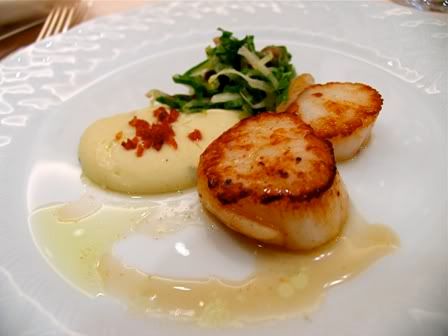 There being no white wines served, the 2005 Michel lynch Reserve, the least heavy among the reds present, was the logical choice to pair with the Pan-Seared Sea Scallops, Blue Cheese and Cauliflower Purée, Crisp Spanish Chorizo, Arugula and Black Truffle Oil.
There being no white wines served, the 2005 Michel lynch Reserve, the least heavy among the reds present, was the logical choice to pair with the Pan-Seared Sea Scallops, Blue Cheese and Cauliflower Purée, Crisp Spanish Chorizo, Arugula and Black Truffle Oil.Thereafter, on its own, I tried the...
2005 L'Ostal Cazes Minervois la Livinière - J-M Cazes vinous venture in the Languedoc-Roussillon region of southern France, Minervois la Livinière is a relatively new (created in the late '90s), 200 hectare specific "sub-commune" made up of 6 villages, the most important of which are La Livinière, Cesseras and Siran. As I understand, pursuant to the area's regulations, wines produced must be composed of at least 40% syrah or 40% mourvèdre grapes and the two grapes, together with grenache, must make up at least 60% of the wine. In addition, the wines have to be aged for at least 15 months before bottling, at least 12% alcohol by volume (abv) and yield is limited to 54 hectolitres per hectare.
Generously warm, very concentrated with evident oak lashings, I tasted mostly syrah in this wine and figured it to be pushing above 14% abv. Unabashedly full-bodied, it shows off indulgently rich, sweetishly roasted-ripe black cherry, black currant and raspberry flavors touched with notes of black pepper, tobacco, violets, a touch of dried Provençal herbs and considerable oak. Quite forward and powerful, I'd pair this with hearty roast meats and game, particularly wild duck, boar and venison.
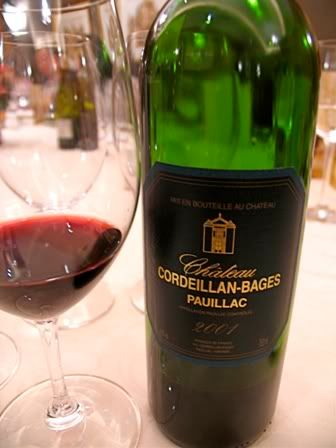 2001 Château Cordeillan-Bages - This is the signature wine of Pauillac's very best hotel which boasts of a 2 Michelin star restaurant run by Thierry Marx. Cordeillan-Bages owns a tiny 2-hectare vineyard in the south of Pauillac, on the gravelly ridge of the plateau de Bages adjacent to the hotel and the wine therefrom is made by the Lynch-Bages team.
2001 Château Cordeillan-Bages - This is the signature wine of Pauillac's very best hotel which boasts of a 2 Michelin star restaurant run by Thierry Marx. Cordeillan-Bages owns a tiny 2-hectare vineyard in the south of Pauillac, on the gravelly ridge of the plateau de Bages adjacent to the hotel and the wine therefrom is made by the Lynch-Bages team.I've found vintage 2001 a pretty classic one in general for Haut-Médocs in general, and Pauillac especially, with old-school typicity and admirable structure similar to vintage 1996 - unlike the recent super-ripe, heatwave vintages such as 2003 and 2005 that appeal so much to so-called "California palates". This small production (well under 1000 cases produced annually) is a good example.
Halfway between medium-bodied and full, this was a perfect springboard for the grand vin of the same vintage. Presenting its predominantly cabernet sauvignon profile of black currant, cedar and underlying black coffee discreetly infused with gravel, pencil lead and violets, it foreshadowed on a lighter frame it's bigger brother's serious depth and complexity.
With the main course of Pepper Roasted Rack of Lamb, Pomme Dauphinoise, Vegetable Ratatouille, Confit of Garlic and Thyme Jus, I had the grand vin.
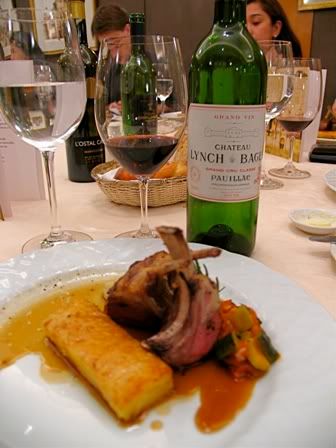 2001 Château Lynch Bages - I tried this at twice before if memory serves; surely once in an International Wine & Food Society function but I wrote no notes thereon. The 2001 harvest for the grand vin vineyards began on the 2nd of October starting with the earlier-ripening merlot with cabernet sauvignon and cabernet franc following a few days later. The weather cooperated with sunny to cloudy days and high temperatures that allowed for healthy ripening.
2001 Château Lynch Bages - I tried this at twice before if memory serves; surely once in an International Wine & Food Society function but I wrote no notes thereon. The 2001 harvest for the grand vin vineyards began on the 2nd of October starting with the earlier-ripening merlot with cabernet sauvignon and cabernet franc following a few days later. The weather cooperated with sunny to cloudy days and high temperatures that allowed for healthy ripening.Moderately fuller and heftier than the 2001 Cordeillan-Bages and with evidently greater depth and complexity, the grand vin of the same vintage discloses earth, leather and subtle warm asphalt and tobacco nuances underlying the slightly smokey dark fruit, cassis, pencil lead, cedar and violets. Its mouth-feel is also more rounded, the middle more pronounced, with good crescendo and expressiveness without at all being loud or over-bearing. Classically cut, its acidity and structure are noteworthy, as well as its moderately long finish.
This was easily the best wine of the lot, which is hardly surprising. Dessert followed, an indulgent Chocolate Truffle Cake with Honey Ice Cream. It sounds simple, but, though I am not overly fond of rich desserts, it was delicious.
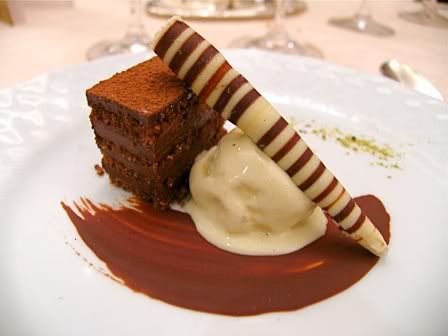 A bracing double espresso during discussions on vine stress, vineyard density and the significance of the number of grapes on each plant brought a close to wonderful lunch. In all, it only remains to be said that we are all most fortunate to have a wide range of J-M Cazes' wines locally available through Bacchus International. In this, the essence of Pauillac, Bordeaux, Châteauneuf-du-Pape and Languedoc-Roussillon is but a mere sip away.
A bracing double espresso during discussions on vine stress, vineyard density and the significance of the number of grapes on each plant brought a close to wonderful lunch. In all, it only remains to be said that we are all most fortunate to have a wide range of J-M Cazes' wines locally available through Bacchus International. In this, the essence of Pauillac, Bordeaux, Châteauneuf-du-Pape and Languedoc-Roussillon is but a mere sip away.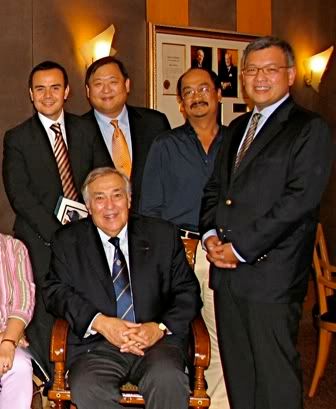
Seated: J-M Cazes; Standing L-R: David Celdran, Alex Lichaytoo, myself & Clifford Lichaytoo





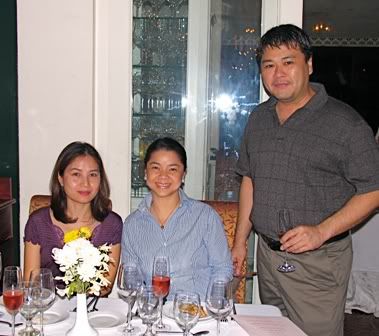
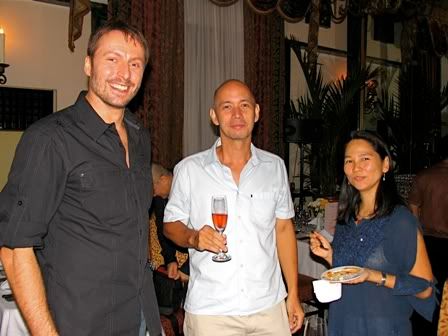
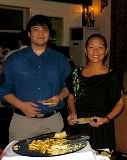
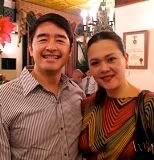
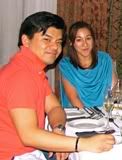
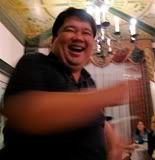
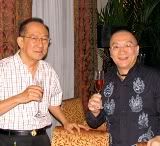
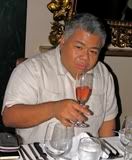
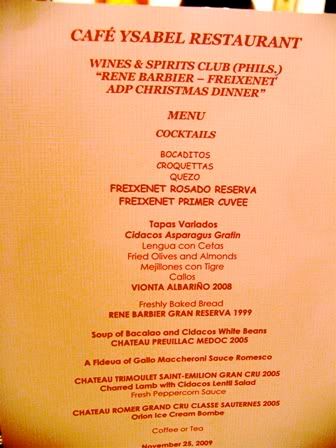 The evening began with welcome glasses of 2 kinds of cava and Aaron's newly available albariño from Rías Baixas...
The evening began with welcome glasses of 2 kinds of cava and Aaron's newly available albariño from Rías Baixas...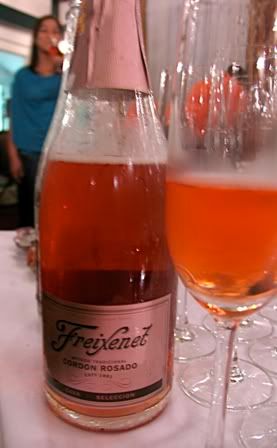 Freixenet Cordon Rosado Brut - I first tried this in
Freixenet Cordon Rosado Brut - I first tried this in 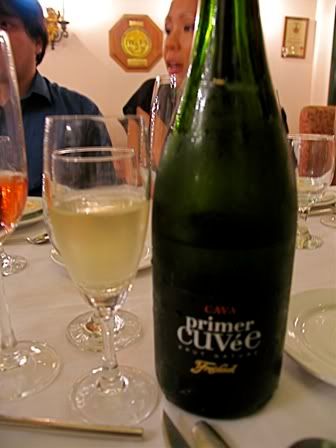 Freixenet Cava Primer Cuvée Brut - A rather straightforward, fresh, crisp, bright and pleasant cava, this presents green apple, citrus (there's a bit of lime in there) and mere hints of pear, zesty yeasty topnote, frothy middle. Good acidity makes this come off as very fresh and cleansing. Very easy to drink a lot of this. Liked it with the mejillones (a.k.a., mussels) and croquetas.
Freixenet Cava Primer Cuvée Brut - A rather straightforward, fresh, crisp, bright and pleasant cava, this presents green apple, citrus (there's a bit of lime in there) and mere hints of pear, zesty yeasty topnote, frothy middle. Good acidity makes this come off as very fresh and cleansing. Very easy to drink a lot of this. Liked it with the mejillones (a.k.a., mussels) and croquetas.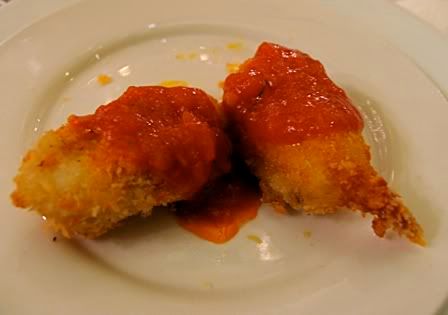 Another fine, traditional/regional match for the mussels was...
Another fine, traditional/regional match for the mussels was...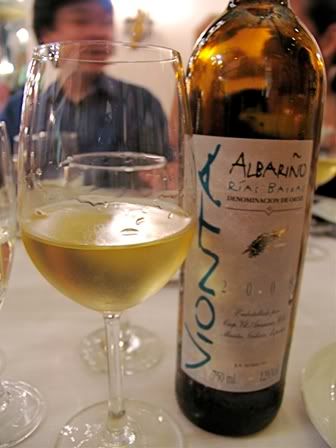 2008 Vionta Albariño - From Rías Baixas in Galicia. I first tried this at
2008 Vionta Albariño - From Rías Baixas in Galicia. I first tried this at 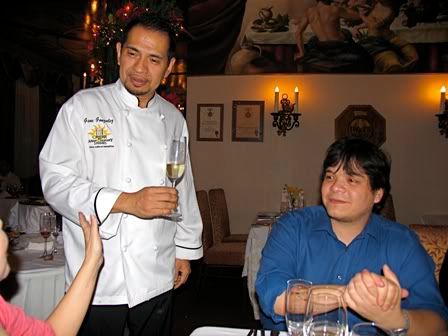 Gene then stopped by our table and my wife re-introduced him to my brother-in-law who I first took to the original Café Ysabel (then on Wilson Street) when Topsy was around 9 or 10 years old. Topsy still remembers the giant chocolate chip cookies of the old Café Ysabel - that was over 20 years ago.
Gene then stopped by our table and my wife re-introduced him to my brother-in-law who I first took to the original Café Ysabel (then on Wilson Street) when Topsy was around 9 or 10 years old. Topsy still remembers the giant chocolate chip cookies of the old Café Ysabel - that was over 20 years ago.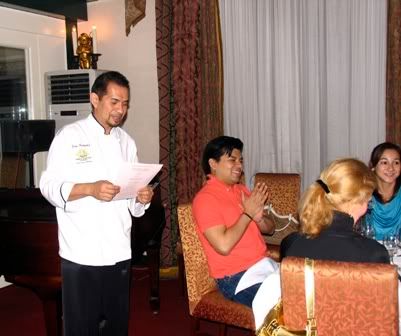 Gene then took the floor, welcomed everyone, introduced the new/first attendance members and guests, thanked Aaron and ADP Enterprises, and gave everyone a brief run-down of the night's menu.
Gene then took the floor, welcomed everyone, introduced the new/first attendance members and guests, thanked Aaron and ADP Enterprises, and gave everyone a brief run-down of the night's menu.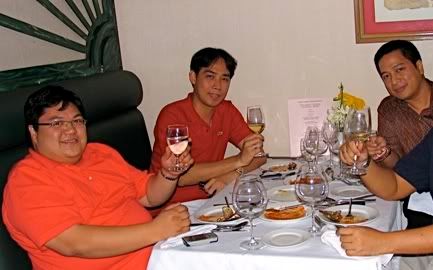
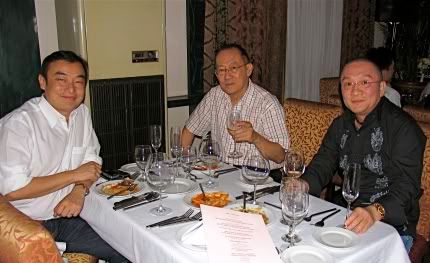
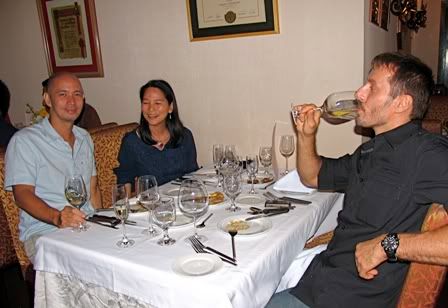
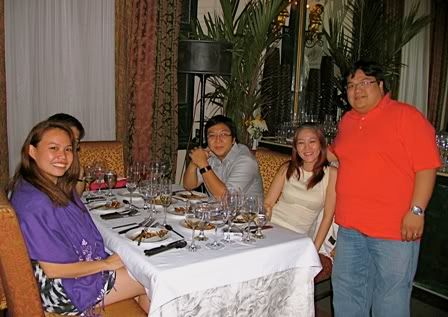 The pica-picas and tapa courses done, dinner proper was served.
The pica-picas and tapa courses done, dinner proper was served.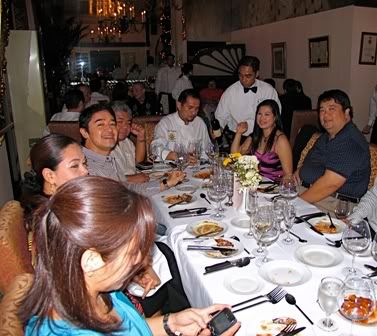 With some hot, freshly baked bread, we had my favorite of the evening's reds.
With some hot, freshly baked bread, we had my favorite of the evening's reds.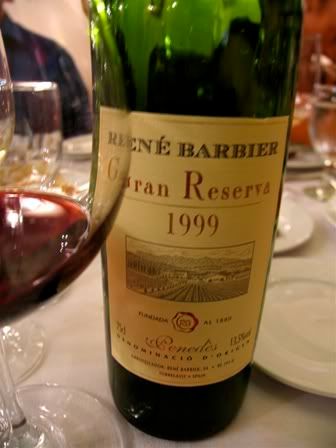 1999 René Barbier Gran Reserva - This is the third time I've had this wine, and I've liked it every single time. At around P1100-1200/bottle, this is an absolute steal for a good, mature Penedés tinto gran reserva. My previous notes are brief, but still applicable.
1999 René Barbier Gran Reserva - This is the third time I've had this wine, and I've liked it every single time. At around P1100-1200/bottle, this is an absolute steal for a good, mature Penedés tinto gran reserva. My previous notes are brief, but still applicable.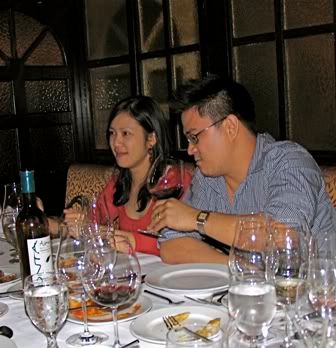 Next was a Soup of Bacalao with Cidacos White Beans...
Next was a Soup of Bacalao with Cidacos White Beans...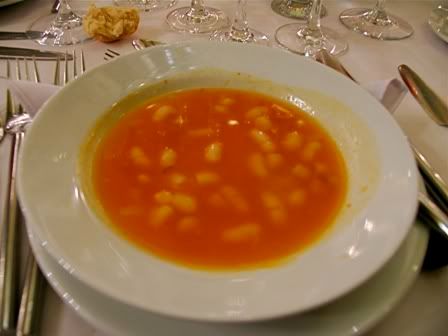 ..followed by a nice "Fideuà" of Gallo Maccheroni with Sauce Romesco with...
..followed by a nice "Fideuà" of Gallo Maccheroni with Sauce Romesco with...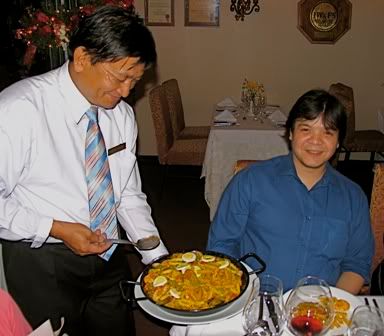 Cosme always used to be the one to serve Topsy in Café Ysabel back in the '90s, and until today.
Cosme always used to be the one to serve Topsy in Café Ysabel back in the '90s, and until today.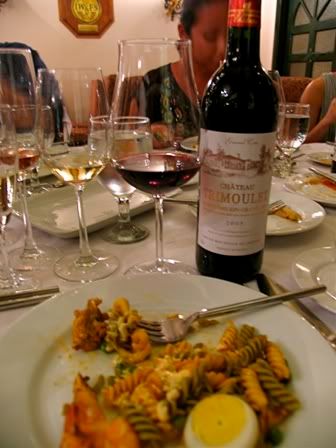 2005 Château Trimoulet - A first for me. I'd never before had wine from this St-Emilion producer. At this early stage, the wine comes off as a bit rustic and old school. It exhibits typical dark plum and black cherry with minor notes of blackberry, espresso, violats, bit of cigar ash and slight spice . The wood/oak-related notes are very mild, leading me to suspect that little new oak is used in the ageing barrels and those have moderate/judicious toasting (good things for me as many seem to have gone whole hog on new oak in 2005 - probably thinking the extremely rich, ripe fruit of '05 could take a lot more of it). Nice balance, good typicity. At P2000/per bottle for a 2005 St-Emilion, it's good to go.
2005 Château Trimoulet - A first for me. I'd never before had wine from this St-Emilion producer. At this early stage, the wine comes off as a bit rustic and old school. It exhibits typical dark plum and black cherry with minor notes of blackberry, espresso, violats, bit of cigar ash and slight spice . The wood/oak-related notes are very mild, leading me to suspect that little new oak is used in the ageing barrels and those have moderate/judicious toasting (good things for me as many seem to have gone whole hog on new oak in 2005 - probably thinking the extremely rich, ripe fruit of '05 could take a lot more of it). Nice balance, good typicity. At P2000/per bottle for a 2005 St-Emilion, it's good to go.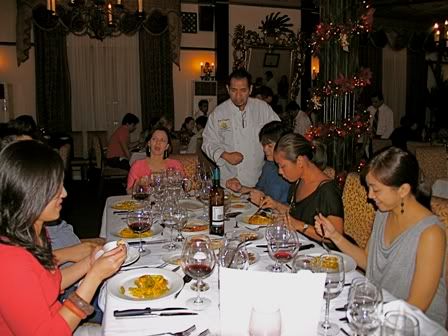 This was followed by my other favorite dish of the evening: Charred Lamb with Cidacos Lentil Salad & Fresh Peppercorn Sauce, paired with...
This was followed by my other favorite dish of the evening: Charred Lamb with Cidacos Lentil Salad & Fresh Peppercorn Sauce, paired with...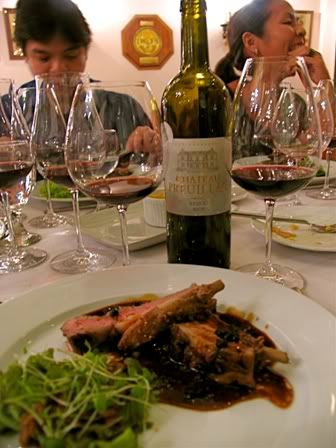 2005 Château Preuillac - Another new one for me, my first taste from this (Médoc) château. Relatively firmly structured, fleshy and definitely ripe-fruited - true to the vintage. This is obviously young and primary and, as far as I could see, was not decanted for aeration beforehand - so I don't think it was fully opened up. That said, its rounded and fleshy, almost chewy, dominant dark fruit (good amount of plumminess suggests a lot of merlot in the blend) and mild oak (like the Trimoulet, probably not much new oak used) on a slightly over medium body was quite pleasing.
2005 Château Preuillac - Another new one for me, my first taste from this (Médoc) château. Relatively firmly structured, fleshy and definitely ripe-fruited - true to the vintage. This is obviously young and primary and, as far as I could see, was not decanted for aeration beforehand - so I don't think it was fully opened up. That said, its rounded and fleshy, almost chewy, dominant dark fruit (good amount of plumminess suggests a lot of merlot in the blend) and mild oak (like the Trimoulet, probably not much new oak used) on a slightly over medium body was quite pleasing.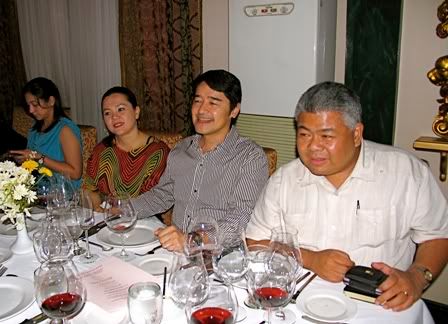 Dessert then followed, an Orion Ice Cream Bombe. One doesn't get to eat the once popular bombes that often these days (the ones made in the old-style spherical molds). A pity, because I do enjoy them. With this we had...
Dessert then followed, an Orion Ice Cream Bombe. One doesn't get to eat the once popular bombes that often these days (the ones made in the old-style spherical molds). A pity, because I do enjoy them. With this we had...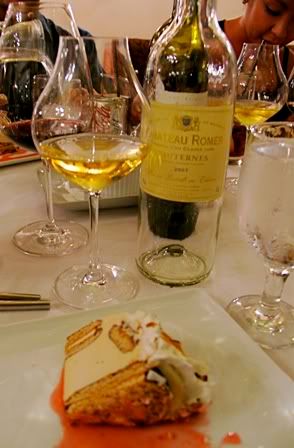 2005 Château Romer - Yet another introductory taste for me. I've never had this producer's wine before. Rather straightforward at this point (as it is very young especially for a Sauternes) in its honeyed, moderately tangy apricot, candied lemon, canned cling peach and lightly creamy oak/vanilla notes. Good acidity, not at all cloyingly sweet. Medium-bodied, good enough focus and a user-friendly character to it. This has many years to go but is already enjoyable, especially when juxtaposed with the cold, creamy bombe.
2005 Château Romer - Yet another introductory taste for me. I've never had this producer's wine before. Rather straightforward at this point (as it is very young especially for a Sauternes) in its honeyed, moderately tangy apricot, candied lemon, canned cling peach and lightly creamy oak/vanilla notes. Good acidity, not at all cloyingly sweet. Medium-bodied, good enough focus and a user-friendly character to it. This has many years to go but is already enjoyable, especially when juxtaposed with the cold, creamy bombe.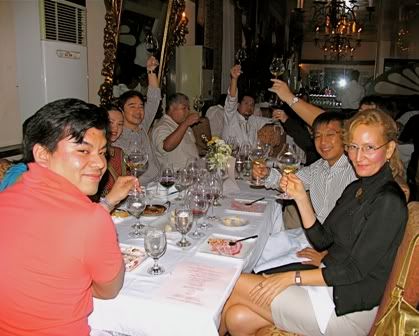 Gene then called out his kitchen crew to receive our thanks.
Gene then called out his kitchen crew to receive our thanks.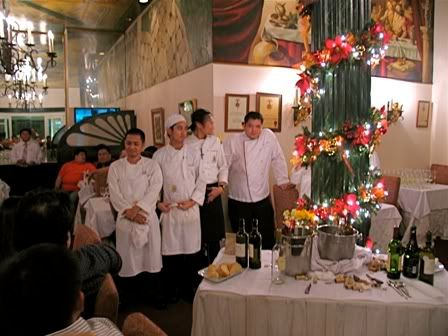 I recall Greg particularly wanted to meet the one who made the lamb course. I could well understand as the lamb was my favorite dish of the evening as well.
I recall Greg particularly wanted to meet the one who made the lamb course. I could well understand as the lamb was my favorite dish of the evening as well.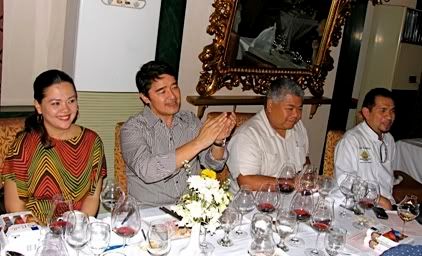 Gene then offered us all a bonus eau de vie as a digestif...
Gene then offered us all a bonus eau de vie as a digestif...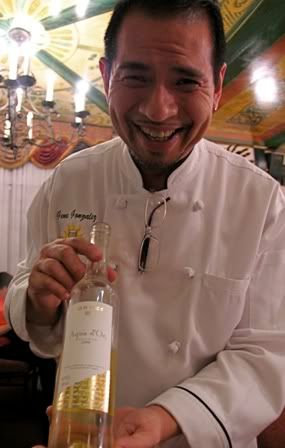
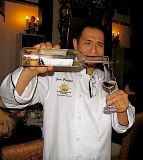
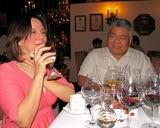
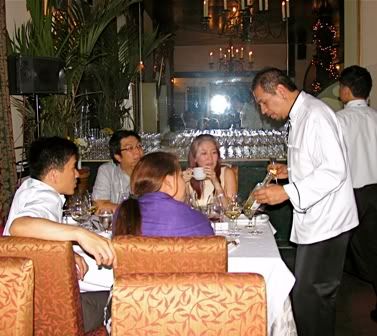 Night deepened, encroaching on the day, most others had already taken their leave, with J-lab, my wife and I lingering with Gene over the Aqua d'Or and old stories. It was another fun evening with the WSCP thanks to Aaron and Gene. As always, until the next.
Night deepened, encroaching on the day, most others had already taken their leave, with J-lab, my wife and I lingering with Gene over the Aqua d'Or and old stories. It was another fun evening with the WSCP thanks to Aaron and Gene. As always, until the next.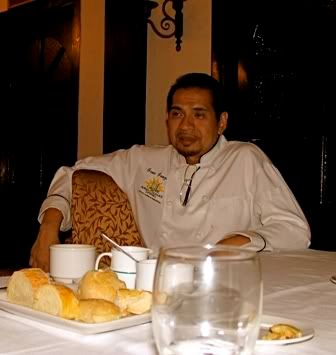
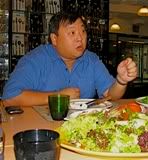
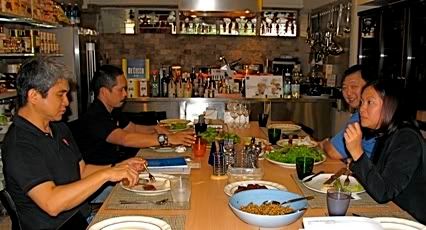 Discussions started with yet another beautifully crisp salad (with artichokes this time) and a report on the number of people attending.
Discussions started with yet another beautifully crisp salad (with artichokes this time) and a report on the number of people attending.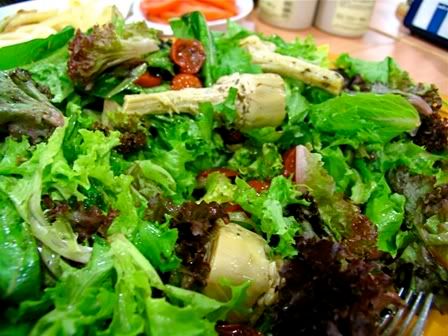
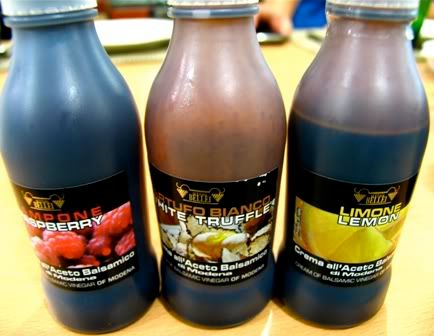 Initially, it was planned that the inaugural dinner was to be for 100 people, but we wound up expanding to around 120, more-or-less, with a reported 30++ person waiting list. All of us who had committed a table of 10 each two meetings ago had already delivered and paid up. The Vigneron had delivered a lot more.
Initially, it was planned that the inaugural dinner was to be for 100 people, but we wound up expanding to around 120, more-or-less, with a reported 30++ person waiting list. All of us who had committed a table of 10 each two meetings ago had already delivered and paid up. The Vigneron had delivered a lot more.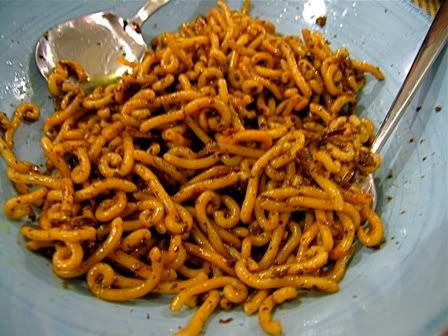 There was some nice, earthy pasta on the table, as well as a platter of seared corned beef slices. Alex offered to cook everyone up some burgers, but I declined. The foregoing was more than enough for me.
There was some nice, earthy pasta on the table, as well as a platter of seared corned beef slices. Alex offered to cook everyone up some burgers, but I declined. The foregoing was more than enough for me.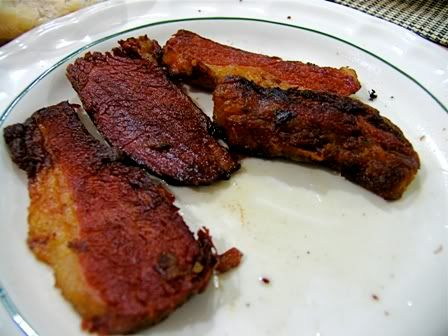

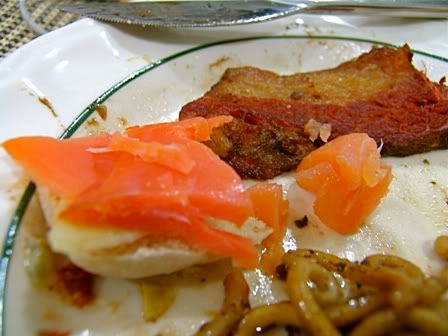 My personal favorites were the melt-in-your-mouth Smoked Magret de Canard...
My personal favorites were the melt-in-your-mouth Smoked Magret de Canard...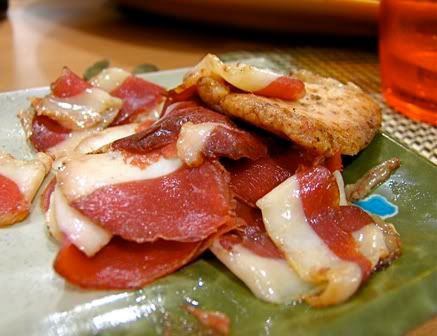 ...and the sinfully good seared-then-roasted foie gras. The latter, is, as I understood, a relatively new product they are selling at the Epicerie - a lot of individual single, serving-sized cuts of foie that are blast frozen and come in a resealable bag. Thus, one doesn't have to thaw and cook a whole foie every time serves it at home (like I have always done). Incredibly convenient. Easy to cook as well since you don't have to carefully slice up the foie and risk crumbling the stuff.
...and the sinfully good seared-then-roasted foie gras. The latter, is, as I understood, a relatively new product they are selling at the Epicerie - a lot of individual single, serving-sized cuts of foie that are blast frozen and come in a resealable bag. Thus, one doesn't have to thaw and cook a whole foie every time serves it at home (like I have always done). Incredibly convenient. Easy to cook as well since you don't have to carefully slice up the foie and risk crumbling the stuff.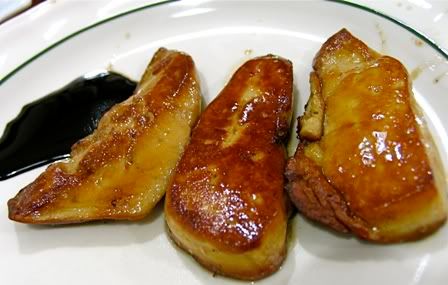 Per Alex and Clifford, you simply take from the bag as many slices you want each time, sear each side over medium heat until caramelized (approximately 1-2 minutes per side) and pop in a 350º oven for another minute or two. Voila - instant foie gras. The Stockbroker bought a whole bag for his wife right then and there. It is very good quality, and most convenient to have at home.
Per Alex and Clifford, you simply take from the bag as many slices you want each time, sear each side over medium heat until caramelized (approximately 1-2 minutes per side) and pop in a 350º oven for another minute or two. Voila - instant foie gras. The Stockbroker bought a whole bag for his wife right then and there. It is very good quality, and most convenient to have at home.
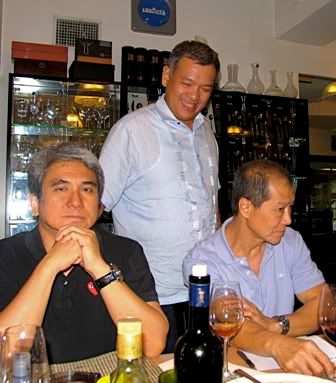
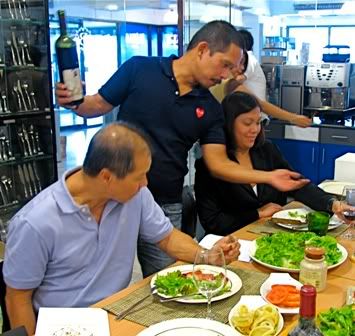
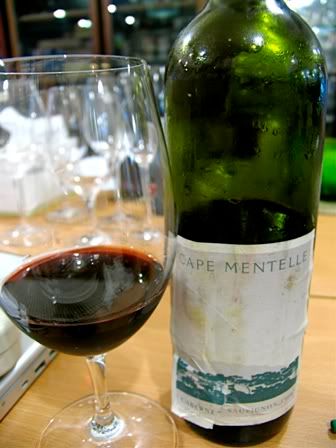 1998 Cape Mentelle Cabernet Sauvignon - I think this is the first time I've tried an Aussie red from Bernie, and am sure this is the first time I've heard about this producer (not that I know much about Aussie wine). Bernie and the Stockbroker told me that it was a very Bordeaux-esque wine and could possibly be mistaken for one if tasted blind.
1998 Cape Mentelle Cabernet Sauvignon - I think this is the first time I've tried an Aussie red from Bernie, and am sure this is the first time I've heard about this producer (not that I know much about Aussie wine). Bernie and the Stockbroker told me that it was a very Bordeaux-esque wine and could possibly be mistaken for one if tasted blind.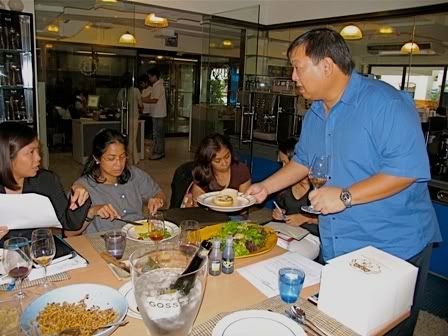 Bernie had one of Alex's burgers as his main course. What does a 6-term president and wine master of the International Wine & Food Society have with his burger, you may ask?
Bernie had one of Alex's burgers as his main course. What does a 6-term president and wine master of the International Wine & Food Society have with his burger, you may ask?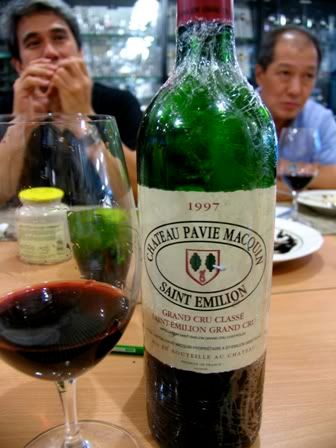 1997 Château Pavie Macquin - I do enjoy trying out so-called "off-vintage" Bordeaux from good makers - relishing finding ones that thumb their noses at professional reviewers' sweeping vintage assessments and, occasionally, precipitately dismissive notes. One such less than a year ago was a forgotten
1997 Château Pavie Macquin - I do enjoy trying out so-called "off-vintage" Bordeaux from good makers - relishing finding ones that thumb their noses at professional reviewers' sweeping vintage assessments and, occasionally, precipitately dismissive notes. One such less than a year ago was a forgotten 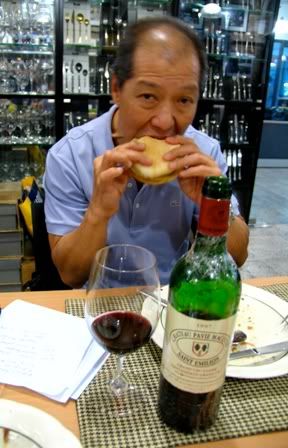 With the above-mentioned foie gras and as dessert, we enjoyed...
With the above-mentioned foie gras and as dessert, we enjoyed...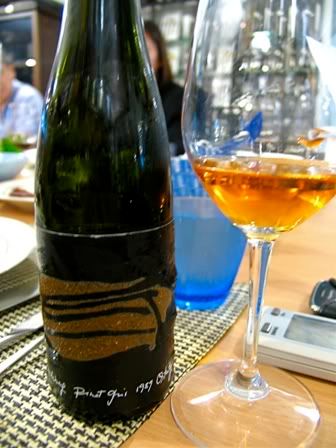 1989 Domaine André Ostertag Pinot Gris Sélection de Grains Nobles - Opulent, thick, luxuriously lush and rounded (it is botrytised after all), spicy-and-floral, sweet/honeyed kumquat, super-ripe peach, confited pear and pineapple with hefty, well-integrated vanilla/oak. Acidity was pretty much adequate, keeping the wine from being too cloyingly sweet. Very nice with the foie and well-suited as dessert in itself.
1989 Domaine André Ostertag Pinot Gris Sélection de Grains Nobles - Opulent, thick, luxuriously lush and rounded (it is botrytised after all), spicy-and-floral, sweet/honeyed kumquat, super-ripe peach, confited pear and pineapple with hefty, well-integrated vanilla/oak. Acidity was pretty much adequate, keeping the wine from being too cloyingly sweet. Very nice with the foie and well-suited as dessert in itself.